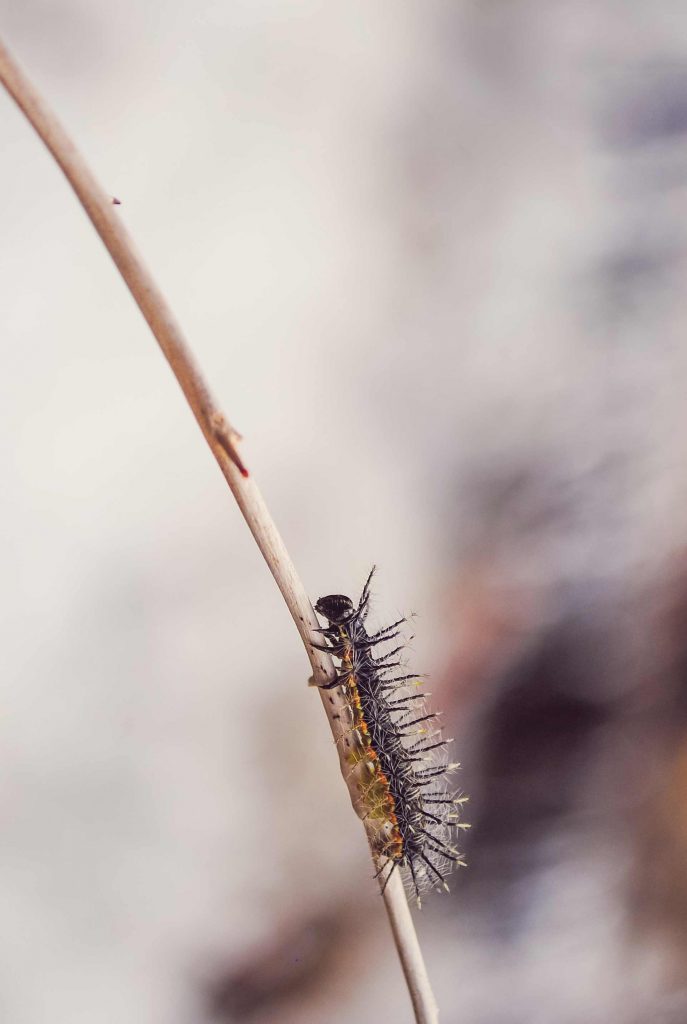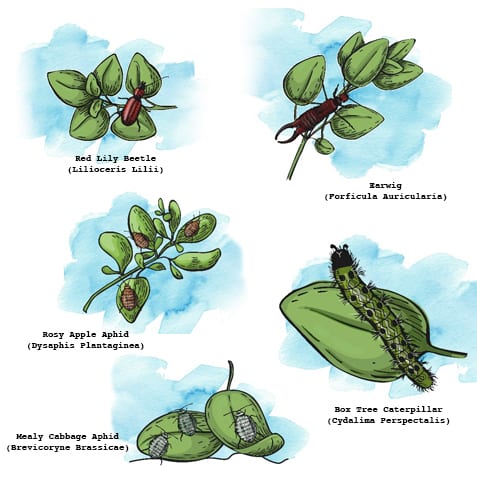Appropriately named, garden pests make their home on our plants and trees, feeding off foliage or the insects attracted to them. The problem is, they cause damage to their hosts in the process. Every budding gardener will encounter pests at some point and the cat and mouse game can become frustrating, undoing a great deal of hard work. Here’s a look at some of the most common found in the UK and a few eco-friendly garden pest control options to try…

Eco-Friendly Garden Pest Control
Red Lily Beetle (Lilioceris Lilii)
This colourful little creature can do some serious damage. With identifying red wings and the ability to fly, you’d assume this pest would be easy to spot, so it’s surprising that the Red Lily Beetle often goes so undetected.
The tell-tale sign that you may have Red Lily Beetles is holes in the leaves of your lilies and fritillaria. Their grubs cause the most damage of all, but luckily these plants can survive some gnawing, so pay attention to attacks in early summer on the bulbs and foliage. This can result in underdevelopment and stop the plant flowering until the following year.
Although the plants can tolerate these pests on a small scale, in some cases they can persist. Try removing the eggs and larvae by hand.
Earwig (Forficula Auricularia)
One of the better-known pests, many of us will already be familiar with the distinctive features of the common earwig. Characterised by their two end pincers, these creatures are hard to mistake but their brown colouring is great camouflage in the soil.
Earwigs damage a range of flowers, from dahlia to chrysanthemums by eating their leaves and petals, but did you know they can actually be beneficial to the flourishing of your fruit trees? Earwigs feed on aphids that attack the fruit, so they are, in a sense, pest control in their own right!
If your flowers are really suffering, it’s best to initially try trapping these pests. Placing upturned flowerpots loosely stuffed with hay or straw amongst the plants being attacked can be useful for monitoring their numbers, but also be a great way to move them over to fruit trees where they can work their magic.

Rosy Apple Aphid (Dysaphis Plantaginea)
The clue is in the name, these garden pests target apple trees. Carefully coloured the same shade of rosy red, they are hard to spot when in action. They feed on the sap and distort the foliage and fruit of the plants they feast on, causing leaves to curl and turn a yellowish colour, preventing healthy fruit development.
As mentioned above, earwigs are a natural way to control aphids, among other natural enemies such as ladybirds and wasps. Light infestations are tolerable and by encouraging wildlife to visit and make home in your garden to flourish, the circle of life can help keep numbers under control.
Box Tree Caterpillar (Cydalima Perspectalis)
The Box Tree Caterpillar, as the name suggests, affects the growth of box plants. Its greenish-yellow colouring and black head is perfect for writhing undetected through the leaves of its chosen prey.
They feed within webbing and these small but deadly pests can completely defoliate box plants. If you spot the webbing, start searching for pale yellow, flattish eggs on the underside of box leaves – this is how you can judge the severity of the infestation.
If the infestation is extensive this can be treated with an insecticide. Organic contact insecticides containing natural pyrethrins (e.g. Bug Clear Gun for Fruit & Veg, Ecofective Bug Killer). Several applications of these short persistence products may be necessary to give good control. This has to be thorough and forceful in order to penetrate the strong silk webbing.
Mealy Cabbage Aphid (Brevicoryne Brassicae)
This pest is extremely versatile, targeting a huge range of plants. Cabbages to cauliflowers, spinach to sprouts. Look out for small critters with white greyish skin and the waxy residue they leave behind.
The pests shed their skin along with a sticky substance which could come infected by a sooty mould. They are usually found on new leaves and target vulnerable young plants. Luckily, they have many predators who naturally keep their population under control. However, if the problem persists, try organic sprays, fatty acids or plant oils for an eco-friendly control.
Christine




